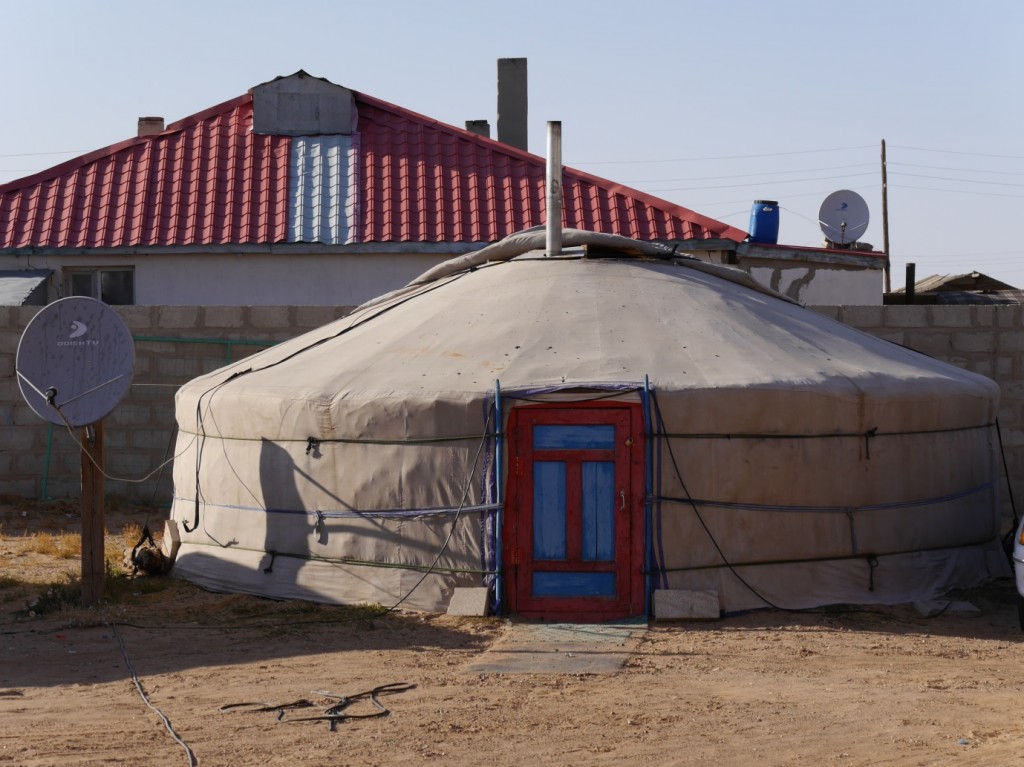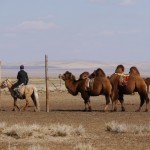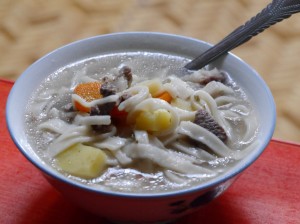Mongolia
住在北京最大的好处可能是去其他地方十分的便宜和方便。虑到中国国庆节长达一周的假期,我和几个朋友决定尽可能远离北京拥挤的人群和污蒙古 世界上最地广人稀的国家。毫无疑问,这次的旅行是一次探险。从扣人心弦到光怪陆离的景色,我们 毫无疑问地收获了很多的经历.
第一个探险是从中国越过边境。人们不可能步行穿过边境线,相反,每天有几百辆苏俄的吉普车载人穿过。我们找到了吉普车,并且将几个可疑盒子放上车,然后就开始穿越边境。越过边境以后,我们发现中国跟蒙古的明显差异。从没有白云的清澈的蓝天到没有城市的一马平川, 我们觉得我们肯定离北京很远了。
然而,当我们到达乌兰巴托后,就发现乌兰巴托作为世界上污染最严重的城市之一,它和北京没有太大的区别。我们游览了所有的旅游景点:蒙古议会大厅、无数的成吉思汗纪念碑和我最喜欢的政治受害者的博物馆。更加奇异的经验包括在北韩的饭馆吃饭以及观看蒙古国际歌剧。虽然我们一个词也听不懂,但是这些多彩的传统服装和那些令人难以忘怀的半裸的蒙古摔跤手的外貌,都使得这些歌剧非常有趣。
在乌兰巴托享受了几天比较豪华的旅社, 我们离开了首都来开始接下来的旅程。在蒙古没有遍布全部的铁路,在无止境的没有铺好的道路上,公共汽车也十分有限,因此如果没有一个司机,在这个广大的国家是不可能四处旅行的。在特殊的苏俄篷车,我们又开车游览了一座寺院,戈壁沙漠和温泉。
我们晚上在蒙古游牧民族的圆顶帐篷休息。因为小屋不绝缘,而且只有小加热炉,所以我们很快的发现我们需要在非常寒冷的夜里穿很多衣服。我们有一天早上在泡温泉,我们走出小屋的时候发现了很厚的白雪,然后我们在白雪中享受泡温泉。更加令人惊奇的是,我们在第二天来到了戈壁沙漠,并且在沙丘中骑骆驼。
这次旅行中最难忘的部分就是蒙古美妙的风景。最好的例子是在俄罗斯边境的湖泊。我们在拥挤的公共汽车里,在坎坷不平的道路上经过了二十小时的旅行之后,我们十分期待这个湖泊。很幸运,我们一点也不失望。我们乘坐马车,沿着172km湖泊的部分路线行走,而且我们还看见了群山环绕的清澈透明的湖水,这些风景真的很状况。
尽管存在很大的语言障碍,我们遇到的蒙古人都非常的愉快以及热情好客。 我们在农村的家庭吃中饭的时候,他们不停的给我们牦牛饼和木马牛奶。似乎他们知道的唯一的英文单词是“吃”,他们在给我们更多饼的时候尽可能地用这个词。但是蒙古的菜有时候比较难吃。传统菜包括开羊肉、下水饼和新酿的牦牛奶。虽然我们尽量试吃当地的菜,我们最终还是依靠吃我们的燕麦饼干来生存。尽管回到北京的时候,我们可能会变瘦,也可能有营养不良,但是蒙古的确是对北京严重污染的最好补救。
ENGLISH TRANSLATION:
Perhaps the biggest advantage of living in Beijing is the ease and low cost of transport elsewhere. Given the week long holiday to celebrate Chinese national day, a few friends and I decided to get as far away from the crowds and pollution of Beijing as possible: Mongolia, the world’s most sparsely populated country. The trip was definitely an adventure. From the breath-taking to the bizarre, we certainly encountered a wide range of new experiences.
The first adventure was crossing the border from China. This cannot be done on foot, instead hundreds of dilapidated Soviet-era jeeps ferry people across every day. We duly found a jeep and after several suspicious boxes were loaded in with us, crossed the border. Once across, the difference between China and Mongolia was immediately obvious. From the cloudless clear blue sky to the expanse of land with not a single settlement in sight, we certainly felt a long way from Beijing.
However, once we arrived in Ulaanbataar we were disappointed to discover that as one of the world’s most polluted cities, it was not so different after all. We saw all the tourist sights: the parliament building, endless Genghis Khan monuments and, my particular favourite, a rather ramshackle building that was the Museum for Victims of Political Persecution. More bizarre experiences included a meal at a North Korean restaurant and a visit to the Mongolian National opera. Despite not understanding a word of the singing, the colourful traditional costumes and unforgettable appearance of some semi-naked Mongolian wrestlers made the opera thoroughly entertaining.
After a few days in relative luxury staying in a hostel in Ulaanbataar, we left the capital to start the next leg of the trip. With no national railways outside the capital and very limited bus services on the endless unpaved roads, travelling round the vast country is impossible without a driver. In our quirky Soviet style camper van we were driven across the country to visit Kharkhorin monastery, the Semi-Gobi desert and the Tsenker hot springs.
Nights were spent in Mongolian nomad’s huts called Gers. With little insulation and heated only by a stove, we quickly learnt to wrap up warm during the sub-zero nights. One morning at the hot springs, we woke up to a thick layer of snow and enjoyed a dip in the warm pools in the snow. Extraordinarily, the next day we drove to the semi-Gobi desert and rode camels in the arid sand dunes.
Without a doubt the most unforgettable part of the trip was the breath-taking scenery. The best example of this is that of Lake Khovsgol right next to the Russian border. After a 20 hour journey on an overcrowded coach driving through unbelievably bumpy unpaved roads, we had high expectations of the lake. Fortunately we were not disappointed; on a horse trek along part of the 172km long lake and were rewarded with spectacular views of the crystal clear water offset by the surrounding mountains.
Despite a substantial language barrier, everyone we encountered was cheerful and exceptionally welcoming. We stopped for lunch in the home of a rural family and were presented with an endless supply of Yak’s cheese pancakes and Mare’s milk. The only English they seemed to know was “eat” which they made full use of while pressing more pancakes into our hands. However, the Mongolian diet was a challenge to enjoy at times. Traditional fare includes boiled mutton, fried offal pancakes and a drink of fermented yak’s milk. While we did try our best to experience the local cuisine, we inevitably ended up relying on cereal bars and biscuits to survive. Despite returning to Beijing several kilos lighter and with borderline malnutrition, Mongolia and the perfect remedy to the oppressive smog in Beijing.



